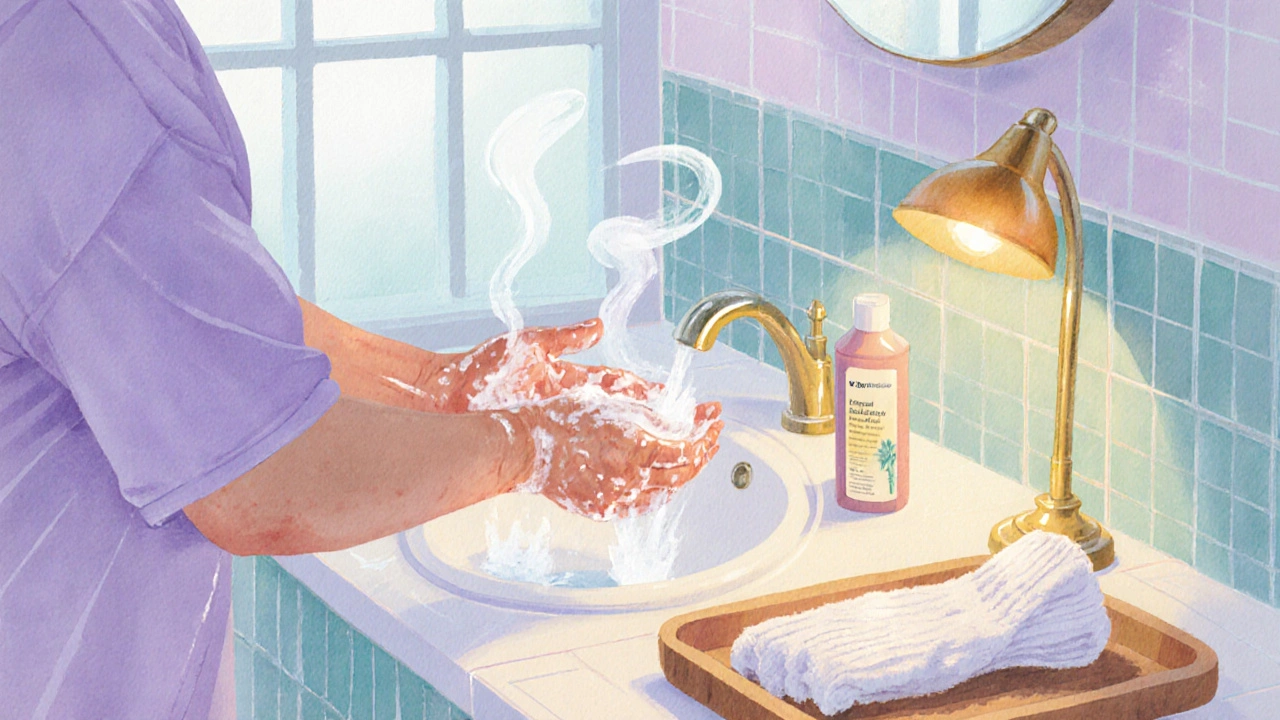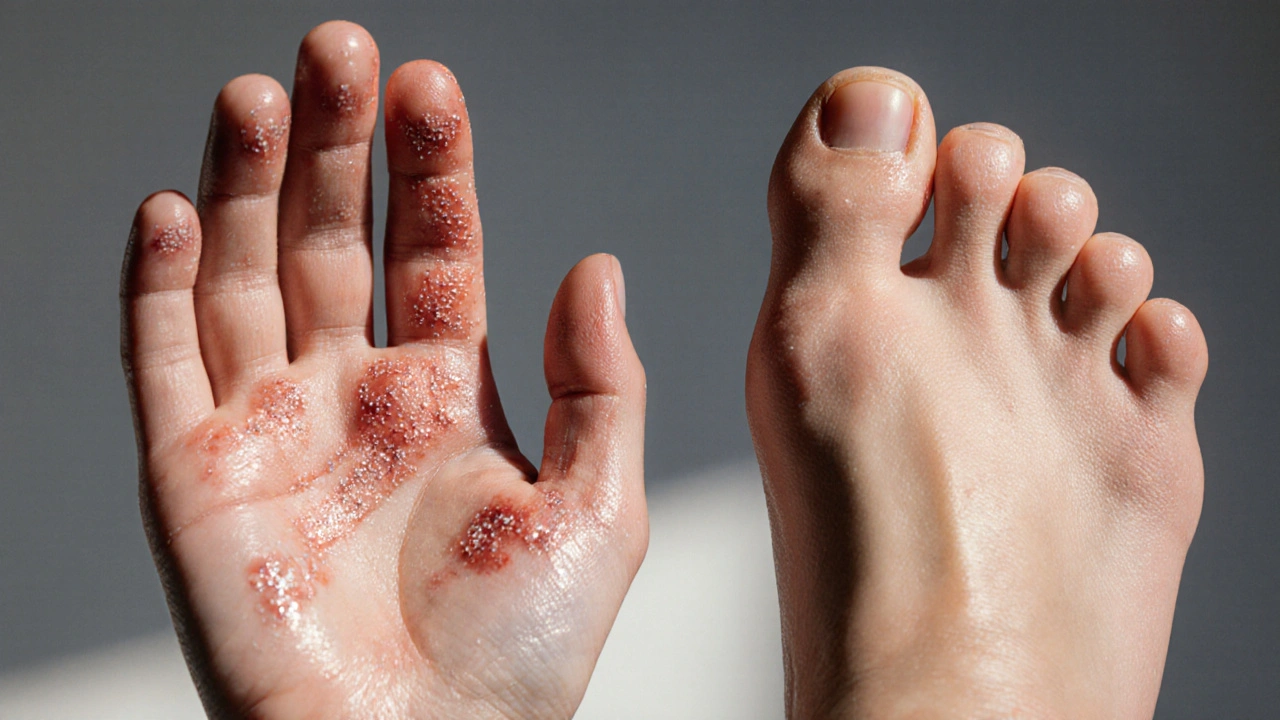Plaque Psoriasis Severity Tracker
Assess Your Symptoms
Quick Takeaways
- Identify early signs - thick red patches, silvery scales, itching or burning on palms and soles.
- Commit to a twice‑daily moisturizing routine; thick creams work best.
- Start with mild topical corticosteroids or vitamin D analogues; step up only if needed.
- Watch for triggers such as stress, harsh chemicals, or cold‑dry weather.
- Seek a dermatologist if plaques cover more than 10% of your hand or foot surface or if pain interferes with daily tasks.
What Is Plaque Psoriasis on the Hands and Feet?
When you notice thick, red patches on your palms or soles, you might be dealing with plaque psoriasis, a chronic skin condition that produces silvery scales and itchy plaques on the skin. In the hands and feet, the disease can make everyday tasks painful, and because the skin is thicker there, symptoms often look more stubborn than on other parts of the body. plaque psoriasis hands and the matching foot involvement are sometimes called palmoplantar psoriasis.
Spotting the Early Signs
The first clues usually include:
- Well‑defined, raised plaques that are red or pink.
- Fine, silvery-white scales that may crack.
- Itching, burning, or soreness that worsens after manual work.
- Occasional nail changes, such as pits or separation.
If you see these signs for more than two weeks, start a self‑care plan and consider a professional check.
Common Triggers and How to Keep Them in Check
Everyone’s flare‑up triggers differ, but the most frequently reported ones are:
- Stress - cortisol spikes can worsen inflammation.
- Cold, dry air that dries out the skin barrier.
- Frequent hand‑washing or exposure to harsh detergents.
- Alcohol, smoking, and a diet high in processed sugars.
Keeping a simple diary for a few weeks helps you link flare‑ups to specific activities or foods.
Building a Daily Skincare Routine
A solid routine is the backbone of any hand‑foot psoriasis plan.
- Cleanse gently. Use a fragrance‑free, pH‑balanced cleanser. Avoid hot water; lukewarm is best.
- Moisturize immediately. Within three minutes of washing, slather on a thick ointment or cream. Look for ingredients like petrolatum, ceramides, or glycerin.
- Seal the moisture. For extra protection, cover the treated area with a cotton glove or sock overnight.
- Exfoliate cautiously. Once a week, use a soft keratolytic (see below) to soften scales before moisturizing.
Consistency matters - missing a day can set back progress.

Topical Treatment Options
Topical therapy is usually the first line because it targets the lesions directly and carries fewer systemic risks.
Topical corticosteroids are anti‑inflammatory creams that reduce redness and scaling. Low‑to‑moderate potency (e.g., hydrocortisone 1% or betamethasone valerate 0.1%) works well for thin skin on the palms, while higher‑potency options (clobetasol propionate 0.05%) may be needed for thicker plantar plaques. Vitamin D analogues such as calcipotriene help normalize skin cell growth. They’re often combined with a steroid to boost effectiveness and lower irritation. Keratolytic agents (e.g., salicylic acid 3‑6%) dissolve the extra dead cells, making other topicals penetrate better. Apply after washing, let it sit for a few minutes, then rinse and moisturize. Topical retinoids like tazarotene can be useful for stubborn plaques, but they may cause a burning sensation, so start with a low dose.Quick Comparison of Common Topicals
| Treatment | Typical Strength | Best Use | Pros | Cons |
|---|---|---|---|---|
| Topical corticosteroid | Low‑to‑high potency | Reducing inflammation quickly | Fast relief, inexpensive | Skin thinning with long‑term use |
| Vitamin D analogue | Calcipotriene 0.005% | Controlling scale buildup | Low irritation, good for maintenance | May cause itching; slower onset |
| Keratolytic (salicylic acid) | 3‑6% | Preparing thick plaques for other meds | Improves penetration, cheap | Can irritate broken skin |
Beyond Topicals: When to Consider Advanced Therapies
If plaques cover more than 10% of your hand or foot surface, or if they’re extremely painful despite consistent topical use, a dermatologist may suggest:
- Phototherapy - targeted UV‑B light can calm inflammation without systemic meds.
- Biologic therapy - injections that block specific immune pathways (e.g., IL‑17, IL‑23 inhibitors). These are usually reserved for moderate‑to‑severe disease.
- Systemic oral agents such as methotrexate, though these carry more monitoring requirements.
These options are effective but require specialist oversight, baseline blood tests, and regular follow‑ups.
Lifestyle Adjustments that Support Healing
Even the best cream won’t work if you keep aggravating the skin.
- Protect your hands. Wear cotton gloves when handling cleaning products; use padded shoes for long standing.
- Stay hydrated. Drinking 2‑3L of water daily helps keep the skin barrier supple.
- Mind your diet. Studies from 2023‑2024 show that a Mediterranean‑style diet rich in omega‑3s, fruits, and vegetables can reduce psoriasis severity.
- Manage stress. Short daily meditation or breathing exercises lower cortisol, which in turn can cut flare frequency.
When to See a Dermatologist
Schedule an appointment if you notice any of these red flags:
- Pain that interferes with work or daily chores.
- Rapid spread of plaques across the hand or foot.
- Signs of infection - increased redness, warmth, pus.
- Failure to improve after four weeks of proper topical treatment.
A dermatologist can confirm the diagnosis (sometimes a skin biopsy is needed) and tailor a treatment plan that may include the advanced options mentioned above.
Tracking Progress and Staying Motivated
Use a simple log to record:
- Date of flare‑up.
- Size and location of plaques (e.g., “right palm, 3cm diameter”).
- Treatments used that day.
- Anything that might have triggered the flare (new detergent, stressful meeting, etc.).
Seeing patterns over weeks helps you fine‑tune your routine and gives your doctor concrete data.
Frequently Asked Questions
Can I use over‑the‑counter creams for hand and foot psoriasis?
Yes, low‑strength hydrocortisone (1%) combined with a thick moisturizer can provide modest relief for mild plaques. If you don’t see improvement after two weeks, step up to a prescription‑strength steroid or ask your doctor about vitamin D analogues.
Is it safe to shave the scales off my palms?
No. Shaving or picking at the scales can damage the skin barrier, increase inflammation, and raise infection risk. Instead, use a keratolytic agent to gently soften the scales before moisturizing.
How long does it take to see results from topical treatment?
Most patients notice reduced redness and itching within 3‑7days. Scaling may take 2‑4weeks to clear, especially on the feet where skin is thick.
Will cold weather make my psoriasis worse?
Cold, dry air often dries out the skin barrier, leading to more cracks and flare‑ups. Use a humidifier indoors and keep hands and feet well‑moisturised during winter months.
Are there any natural remedies that actually work?
Aloe vera gel, oatmeal baths, and 5% tea tree oil can soothe mild irritation, but they shouldn’t replace proven medical treatments. They’re best used alongside moisturisers and prescribed topicals.
Managing plaque psoriasis on the hands and feet takes a mix of smart skin care, targeted medication, and lifestyle tweaks. By tracking triggers, staying consistent with moisturising, and knowing when to get professional help, you can keep the condition under control and get back to the activities you love.


Claus Rossler
October 2, 2025 AT 13:46Honestly, the whole 'moisturize twice a day' mantra feels like a laundry‑list suggestion for the uninformed. While the article touts thick creams, I'd argue that occlusive dressings are a far more cerebral approach. Most dermatologists ignore the nuance of vehicle selection, which is a glaring oversight. Moreover, the emphasis on salicylic acid as a prep glosses over potential irritant dermatitis. In short, the guide scratches the surface of a deeper pharmaco‑strategic conversation.
chris mattox
October 11, 2025 AT 19:59Hey folks, let’s remember that psoriasis isn’t just a skin thing-it’s a symphony of triggers that dance across our lives. A splash of lavender‑scented oil might sound dreamy, but the real hero is a fragrance‑free, ceramide‑rich emollient that hugs the skin like a trusty friend. Keep a tiny journal; jot down the soaps, the meals, the moods, and you’ll spot patterns faster than a detective on a cold case. And don’t be shy about swapping out harsh detergents for a buttery hand wash-your palms will thank you with a softer sigh. Stay curious, stay kind to your skin, and the road to calm will unfurl.
Jackson Whicker
October 21, 2025 AT 02:12Behold, the article’s rosy portrayal of topical steroids is nothing short of a Shakespearean tragedy in disguise. It whispers sweet lullabies about “mild to moderate” potency while ignoring the looming specter of adrenal suppression that lurks in the shadows of prolonged use. One must not be lulled into complacency; the true art lies in calibrating the steroid’s strength to the plaque’s depth, a choreography that most lay readers fail to appreciate. Moreover, the cavalier recommendation of vitamin D analogues as a 'maintenance' option betrays an elementary misunderstanding of their pharmacodynamics. In the grand theater of dermatologic therapy, nuance is the protagonist, not the footnote. Thus, dear readers, venture beyond the script and interrogate your dermatologist with the zeal of a philosopher confronting a dogma.
Audrin De Waal
October 30, 2025 AT 07:26Listen up, mates-our skin is the frontline of our heritage, and letting plaque run rampant is like surrendering our flag without a fight. The guide forgets that traditional remedies, like neem oil or turmeric paste, have defended us for centuries long before any foreign cream was concocted. Embrace the local wisdom, slap on a thick coconut‑oil based salve, and remember that protecting your hands is protecting the very craft that built our nation. No need for lofty labs when the earth’s own bounty stands ready.
parag mandle
November 8, 2025 AT 13:39When the palms turn into a battlefield of crimson plaques, the first line of defense is a gentle cleanse-think of it as laying down a soft carpet before marching in heavy artillery. Follow that with an occlusive ointment, a barrier so seal‑tight it could rival a medieval castle wall against moisture loss. If the scales refuse to relent, enlist a salicylic acid pre‑treatment; it acts like a skilled scribe, etching away the stubborn script of dead cells so the steroids can truly penetrate. Remember, consistency is your battle cry-skip a night and the siege may crumble.
Shivali Dixit Saxena
November 17, 2025 AT 19:52Okay! Moisturize - twice - daily! Use a thick ointment! Seal it with gloves! 🚀
Sayam Masood
November 27, 2025 AT 02:06One might contemplate the metaphysical interplay between epidermal turnover and external stimuli, for the skin is but a canvas upon which life paints its indiscretions. In this light, the recommendation to pair keratolytics with moisturizers resembles a dialectic synthesis: the thesis of scale removal meets the antithesis of barrier restoration, yielding a harmonious cure. Yet, the article skirts the deeper question of why stress, a silent conductor, often precipitates these eruptions. A holistic approach-mindful breathing, balanced diet, and disciplined sleep-should not be relegated to a footnote. Thus, we must elevate our regimen from a mere protocol to a philosophy of self‑care.
Jason Montgomery
December 6, 2025 AT 08:19Hey crew, think of your skin like a teammate-if you neglect it, the whole squad suffers. Keep a simple routine: wash gently, slap on that heavy cream, cover up at night, and you’ll stay in the game. When a flare hits, don’t panic; just double‑down on the moisturizer and maybe add a short burst of steroid for a quick fix. Remember, consistency beats intensity every time.
Wade Developer
December 15, 2025 AT 14:32Your critique raises valid points about steroid stewardship, yet the article does provide a balanced escalation ladder that many patients find accessible. While we must caution against indiscriminate use, the stepwise approach remains a pragmatic compromise. Ultimately, shared decision‑making bridges the gap between caution and efficacy.
Sandra Perkins
December 24, 2025 AT 20:46Sure, because my skin loves a good drama.